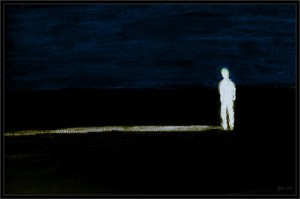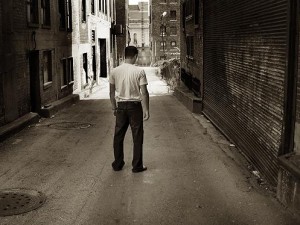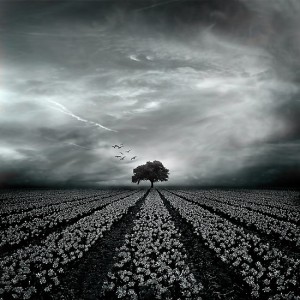 I just finished Yoga for People Who Can’t Be Bothered to Do It by Geoff Dyer and while his writing is humorous and leaves you smiling if not laughing at times throughout in a number of short chapters about his escapes around the world, there are some deep, serious philosophical patches, where blue-Picasso like darkness sets in. From Amsterdam to Cambodia, Rome to Indonesia, Libya to the Burning Man festival in the Black Rock Desert, he flounders about mishaps, break-ups, loneliness, antiquity, art, writing and the inability to, and countless grievances that take on movement and motion in hotel rooms, festivals, airplanes and bars.
I just finished Yoga for People Who Can’t Be Bothered to Do It by Geoff Dyer and while his writing is humorous and leaves you smiling if not laughing at times throughout in a number of short chapters about his escapes around the world, there are some deep, serious philosophical patches, where blue-Picasso like darkness sets in. From Amsterdam to Cambodia, Rome to Indonesia, Libya to the Burning Man festival in the Black Rock Desert, he flounders about mishaps, break-ups, loneliness, antiquity, art, writing and the inability to, and countless grievances that take on movement and motion in hotel rooms, festivals, airplanes and bars.
The book brought me back in time to place when Everything But the Girl and Joe Jackson were hot and Suzanne Vega’s lyrics calmed me via an old fashioned walkman which was glued to my ears on an over year long journey through Southeast Asia. Wry, with a British-like wit and cynicism at times, I couldn’t help but resonate with many of his experiences, especially the endless noises in your head, those demons which on more than one occasion and definitely in more than one country, made sure you didn’t sleep, didn’t relax and didn’t have fun.
I absolutely loved his meanderings most when he was lying along in a hotel room spread eagle on a bed contemplating all the whys in the world, such as the age-old questions of travel: why does one do it? What am I doing here? What do I want out of life? At one juncture while on a jaunt in Libya, he replies in his conciousness: I want to be home, to stay put, to stay in, to put my feet up and watch telly. For the serial traveler, at least if you’ve been doing it for more than twenty years, you can’t help but resonate with that even if you never watch telly. He writes: “It manifested itself as a diminution of everything by which I had previously set the greatest store (vitality, appetite for new things, new challenges) and an intensifying wish for the familiar.”
Then there are the obvious things he points out, which my grandfather would have appreciated. Sometimes I wonder whether my grandfather somewhere out there is actually reading my blog posts. Dyer says, “I like countries where people continue to use things even when they are broken. Why throw them away? Why not keep wearing them till the lenses themselves wear out?” Now that I’m living in the over-consumption state of California, I’m thinking that my grandfather really wanted me to read that. 
And, then he touches on those revelation moments in our lives, at least that’s what he calls them. I’d point out that often those revelation moments aren’t really revelation moments at all, but reflection points when we actually have done nothing other than taken the time to really listen to what our heart is telling us inside rather than our heads, so it’s information and insights we’ve known since we were born, at a visceral level…that data that we accessed during the so called “revelation” moment was always there. Most of the time we’re just too afraid or just not emotionally to access information we already know.
I had an interesting exchange with a friend of mine in a parking lot recently. He’s a CEO of a globally known company and has more money than he’ll ever need in his life or the next three. When we got to those revelation-like insights in our lives, he said to me “I don’t tend to go there.”
Since I often go there, sometimes joyfully and sometimes kicking and screaming, I had to know why of course. He said he was afraid of what he might find and given that life had always been pretty good to him so why stir the kettle so to speak. It was almost as if it was a management decision not to go there. Don’t touch the stuff that works and is profitable but do dig into what’s broken and change it, sometimes obvious, sometimes not.
 I like to dig into both so it’s no wonder I connected with Dyer’s often tormenting words that he openly shares from one moment in time to the next. He writes about a moment in the Rothko Chapel in Houston, Texas: “In that famously nondenominational environment — a place designed to provide a setting for the contemplation of the spirit by those who, like myself, did not feel at home in any of the more traditional places of worship — I felt…nothing. Not a thing. If anything, it all felt slightly bogus. Pious even. I sat there for a good while, surrounded by those impenetrable menus of the artist’s soul, waiting for something to happen, willing on the blood-and-pigment epiphany. But there’s no faking these things: either you have the great experience or you don’t. I knew it was not going to happen. And then it did happen, in the sense that I realized it could never happen indoors.”
I like to dig into both so it’s no wonder I connected with Dyer’s often tormenting words that he openly shares from one moment in time to the next. He writes about a moment in the Rothko Chapel in Houston, Texas: “In that famously nondenominational environment — a place designed to provide a setting for the contemplation of the spirit by those who, like myself, did not feel at home in any of the more traditional places of worship — I felt…nothing. Not a thing. If anything, it all felt slightly bogus. Pious even. I sat there for a good while, surrounded by those impenetrable menus of the artist’s soul, waiting for something to happen, willing on the blood-and-pigment epiphany. But there’s no faking these things: either you have the great experience or you don’t. I knew it was not going to happen. And then it did happen, in the sense that I realized it could never happen indoors.”
He then refers to one of my favorite authors D.H. Lawrence, who experienced a sense of arrival, of “something final,” at Taos Pueblo. “Some places felt temporary on the face of the earth, but Taos, Lawrence thought, retained “its old nodality.” Dyer remarks that it was the same for him there, at Leptis…not a place he had entered, but the dream space of the past. He was in the Zone.
We’ve all been in our own Zones – he even has a chapter dedicated entirely to “it.” How many times in our lives have we actually been in the Zone versus wishing we were actually in the Zone? Those internal voices again at work do their best to keep us far from our internal and external Zones, far from being present, far from being our most honest selves, not just to others, mostly to ourselves. I love the rawness of his writing where you realize exactly there. He’s not alone – we’re all have those caged animal inside of our heads scurrying around wishing for something other than what we have before us. Even those who have evolved to a point where we’re really good at keeping those caged animals at bay, most of the time, they never go away entirely because the human mind is just designed that way. (Refer to Seth Godin’s description of Lizard Brain and Eckhart Tolle’s New Earth. 
While I’ve traveled for months with another person or even a small group, I’ve done a lot more traveling alone in my life and alone is where I tend to have the most interesting conversations, the most unstructured experiences, and feel the most empowered. I also have more time to be in my aloneness in a real way, which often results in feeling less alone. He recalls an incident that was a little eerie, as if he had been in my own shoes or I his, at least twenty times, on the road, in an exchange and then…He writes, “While I had been strolling on my own, I was quite happy. I was in the Zone. No sooner had I begun chatting with this fellow than I was burdened with the most terrible loneliness. That is another thing about the Zone; one moment you can be in it and the next moment, you are no longer in it. You are just in some place, wishing something were different. I said good-bye to my new friend and walked on. I had to be on my own, just so that I would not feel so alone.”
Recently, I asked a girlfriend in LA if she wanted to go on a trip to Europe with me at some point in the next year and she was open to it. I quickly added, “of course since we’ve never been abroad together, don’t worry, we can take our own “alone” time to meander and do our own thing.”
She responded that she didn’t need to do that and it was okay not getting the fact that the comment was for me as much as it was for her and then I realized we wouldn’t travel the same way, even though I knew a trip with her would work because I had already spent a week with her and she had a very easy going nature. “No, you don’t understand girlfriend,” I was internally thinking and saying, “I NEED to walk the streets of wherever I am soaking in the cultural candy as if no one were watching, no one were listening, no one were there but me, my internal voices and my photographic eye.” That silence brings me refuge, that aloneness brings me serenity, that aloneness brings me everything other than loneliness.
The point is shown here when after he was finally on his own again, he sees the clouds around him differently. “A bank of clouds moved swiftly across the ruins of the forum. The sky darkened, brightened, grew dark again. Perhaps it was not the clouds that were moving but the earth itself, going through the motions of its orbit at a furious pace. It was like experiencing time from the perspective of the ruins: years, decades, even centuries whizzing by like a day viewed through a time-lapse camera. For a short while, the stones retained some of the glow that they had absorbed from the sun. Then, as the sky became uniformly grey, the stones faded, dulled. I felt disappointed, cheated.”
 HOW can you feel, see and be with that if you’re with someone else? I’m not saying that it can’t happen and frankly, it HAS happened with me when I was with a fellow traveler, but it’s rare and your fellow mate needs to connect with it at the same time you do to go into their own silence and reflection even if they see and feel the emotions of the clouds in an entirely different way. Ahhh, the beauty of a walkabout in a foreign city or land when you really feel that no one in the world is watching. No one is there except for you and the clouds and the formations and the stones and the ruins and the sun…
HOW can you feel, see and be with that if you’re with someone else? I’m not saying that it can’t happen and frankly, it HAS happened with me when I was with a fellow traveler, but it’s rare and your fellow mate needs to connect with it at the same time you do to go into their own silence and reflection even if they see and feel the emotions of the clouds in an entirely different way. Ahhh, the beauty of a walkabout in a foreign city or land when you really feel that no one in the world is watching. No one is there except for you and the clouds and the formations and the stones and the ruins and the sun…
Here’s another passage that I loved, one which also took me back to a place in time when I felt birds, statues, skies and bodies of water just like this daily rather than at unique and rare snippets in time when I felt the world wasn’t watching. He says of ruins, antiquity and history:
“Ruins — antique ruins at least — are what is left when history has moved on. They are no longer at the mercy of history, only of time. The sea could not be heard. Everything had become still. This is what I had wanted: to experience history as geography, the temporal as the spacial. Wind is the breath of time, hurrying by. Stillness, though, is like the trance of stopped time. Scattered columns, arches, statues. Ancient latrines. Olive trees. The whistling of birds. Columns against the flag of sea and sky, two flat bands of horizontal blue.
Virginia Woolf apparently told Rupert Brooke that the sky between leaves was the brightest thing in nature: a profoundly parochial remark in that it holds true only in the leafy context of Charleston or some English shire.
The sky is brightest around the edge of antique columns. And no line is sharper than the one dividing a column from the sky that frames it. There is a simple, entirely irrational explanation for this: what separates the column from the sky has been worn down — has become thin and therefore sharp – over time. The sky is as close as can be while still remaining distant. The absolute separation between the timeless man-made and the eternal is never as pure as it is in the ruins of Greek or Roman antiquity.”
If this doesn’t bring you to a beautiful and quiet yet surreal moment in time where everything is transparent and softly glittering with a quiet, serene ambient light around you, then you haven’t spent enough time with the ancient and natural world.
I loved the way he took me from world to world and from manic to quiet and from transparent to stuck. The book obviously has nothing to do with yoga, but it does have to do with listening to your inner voices, in his case, the noisy traumatic ones which bring on deep and dark, yet real and honest reflections, but he does it in a way where you can go to your own “internal” whether or not it’s full of a place of angry noise or quiet serenity.

Renee Blodgett is the founder of We Blog the World. The site combines the magic of an online culture and travel magazine with a global blog network and has contributors from every continent in the world. Having lived in 10 countries and explored over 90, she is an avid traveler, and a lover, observer and participant in cultural diversity. She is also the founder of the Magdalene Collection, a jewelry line dedicated to women’s unsung voices and stories, and the award-winning author of the bestselling book Magdalene’s Journey
She is founder of Blue Soul Media and co-founder of Blue Soul Earth as well as the producer and host of the award-winning Blue Soul CHATS podcast, that bridges science, technology and spirituality. Renee also founded Magic Sauce Media, a new media services consultancy focused on viral marketing, social media, branding, events and PR. For over 20 years, she has helped companies from 12 countries get traction in the market. Known for her global and organic approach to product and corporate launches, Renee practices what she pitches and as an active user of social media, she helps clients navigate digital waters from around the world. Renee has been blogging for over 16 years and regularly writes on her personal blog Down the Avenue, Huffington Post, BlogHer, We Blog the World and other sites. She was ranked #12 Social Media Influencer by Forbes Magazine and is listed as a new media influencer and game changer on various sites and books on the new media revolution. In 2013, she was listed as the 6th most influential woman in social media by Forbes Magazine on a Top 20 List.
Her passion for art, storytelling and photography led to the launch of Magic Sauce Photography, which is a visual extension of her writing, the result of which has led to producing six photo books: Galapagos Islands, London, South Africa, Rome, Urbanization and Ecuador.
Renee is also the co-founder of Traveling Geeks, an initiative that brings entrepreneurs, thought leaders, bloggers, creators, curators and influencers to other countries to share and learn from peers, governments, corporations, and the general public in order to educate, share, evaluate, and promote innovative technologies.








